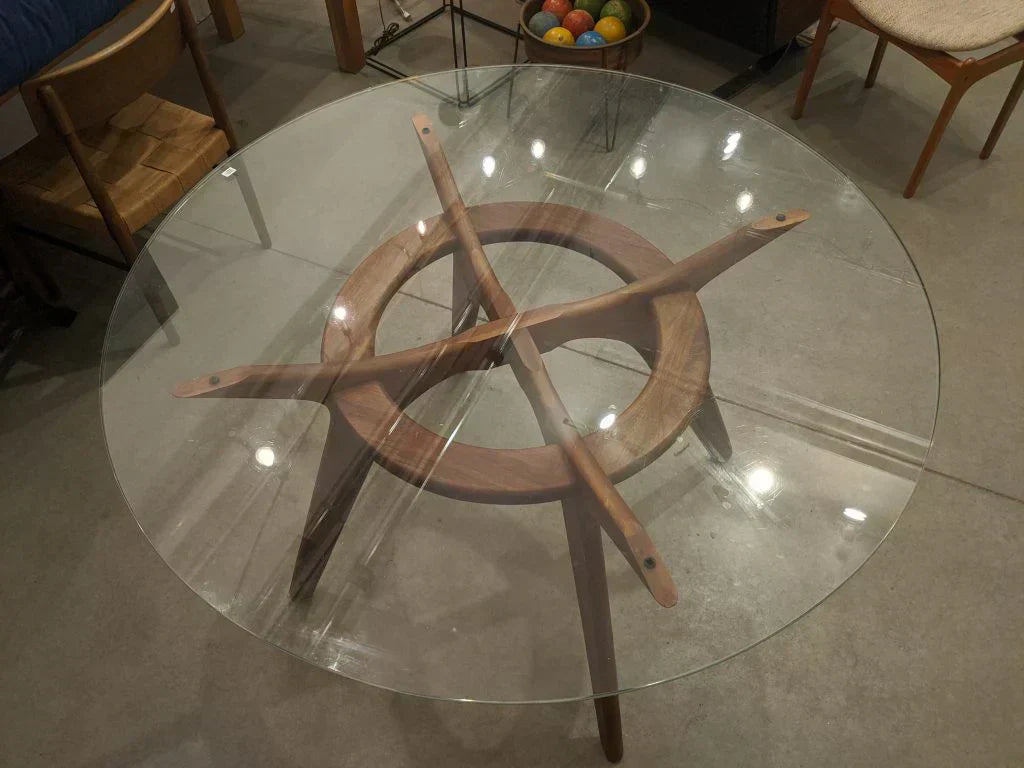Note: While the team at Vermont Woods Studios appreciates the work of Adrian Pearsall, we are not an authorized dealer of pieces created by him, nor do we specialize in repairing original Pearsall furniture. However, we do offer a selection of handcrafted, mid-century inspired designs that celebrate the beautify of solid wood craftsmanship. Browse our full collection of locally crafted pieces or learn more about workshops we do work with.
Adrian Pearsall may not be as widely recognized as other furniture designers like Frank Lloyd Wright or Gustav Stickley, but his contributions to the world of design have not been forgotten. After founding Craft Associates in 1952, Pearsall went on to become one of America’s most prominent furniture designers during the "Atomic Age" of mid-century modern stylings, known especially well for his use of American black walnut.
Adrian Pearsall's Life & Professional Career
 In addition to being a pioneer in the field of furniture design, Pearsall was also an avid sailor, owning many boats over the course of his life. (Image Source)
In addition to being a pioneer in the field of furniture design, Pearsall was also an avid sailor, owning many boats over the course of his life. (Image Source)
Born in 1925 in Trumansburg, New York, Pearsall flashed signs of his lifelong interest in sailing and furniture design at a young age. He joined the US Navy at age 17 and graduated from the University of Illinois in 1950 with a degree in Architectural Engineering. That same year he married his wife Dorie, whom he met on a train en route from his home in NY to his military base in Pennsylvania a few years prior.
Two short years after graduating, in 1952 Pearsall founded Craft Associates. At first, Craft Associates was just Pearsall building furniture in the basement of his Pennsylvania home. Once completed, these pieces were sold out of the back of a truck. Business was slow for the first few years while Pearsall was finding his stylistic voice, but sales started to take off after he started producing his signature walnut base tables with glass tops. Soon after, in the late 1950's, Pearsall's designs were found in renowned department stores throughout the mid-Atlantic, including Macy's and Wanamaker's.
With the company’s growing success, Craft Associates expanded. Soon after Pearsall’s brother Richard joined the business, they opened a factory in Wilkes Barre, Pennsylvania. Craft Associates was one of the top employers in Wilkes Barre through the 1950s and 1960s, growing from 6 employees to over 800 at its peak. In 1969, the company was sold to Lane Furniture Company.
After the sale of Craft Associates, Pearsall went on to launch Comfort Designs in the 1970s with his business partner John Graham. It was in this new venture that Pearsall's designs evolved from mostly walnut tables and chairs to sofa's and upholstery. Not long after founding Comfort Designs, Pearsall left furniture behind to pursue his other calling, sailing and yacht restoration.
Adrian Pearsall passed away peacefully on September 6th, 2011 at his home in Washington Crossing, Pennsylvania.
Fun Fact: In 1998, Adrian would work with his brother once again to design and fund a new home for the Ulysses Historical Society. The museum is now dedicated to Adrian Pearsall.
Adrian Pearsall's Furniture Designs
Adrian Pearsall’s work not only helped define Mid-Century Modern but also the idea that function doesn’t have to be sacrificed for beauty. With much furniture before the mid-century being highly ornate and not overly utilitarian, his work was a much welcome change. Clean lines, organic shapes, soft curves, and walnut wood are just a few elements often found in Pearsall’s furniture.
While Pearsall created 100s of furniture designs between 1952 and the mid-1970s, here are a few he is best known for:

Free-Form Tables: Usually made of walnut and glass, these tables often had curved glass tops and bases that exhibited clean lines and organic shapes. These came in the form of end tables, coffee tables, and dining tables.
Chairs: When it came to chairs, Pearsall dabbled in a little bit of everything. You can find dining chairs, recliners, rockers, and swivel chairs all designed by him. However, while his designs greatly varied, walnut legs and accents are very prominent. It is common to see walnut arms or a walnut grass hopper-legged base on his chair designs. One chair Adrian is known that has nothing to with walnut? The beanbag. While he didn’t design it, he is heavily responsible for its popularization.
Gondola Sofas: Long and low, these sofas with their soft curves came in a variety of upholstery colors, as well as patterns like leopard print, florals, and plaid. They often had a walnut base, with some bases extending beyond the upholstery to create built-in, floating end tables.
Pearsall's Legacy & Impact on American Furniture Design
Pearsall's designs have inspired a slew of others, including the Statements Collection by Copeland Furniture. Pearsall's work designing and popularizing glass top tables with bold, walnut wood bases has influenced many other designers and craftsmen since.
Pearsall was notorious for making “high style” furniture affordable to the masses, namely the middle class. This would become regarded as one of his greatest achievements. While many would say that he created well-made American Modern furniture, others would argue that he was overrated, derivative, and opportunistic.
While Adrian undeniably catered to the mass market and his designs reflected the hunger for modern furniture styles, the popularity of his designs speak for themselves. His furniture was not just highly sought after at its time of creation, but there is a renewed interest in it today—a testimony to his skill and talent. He was also nominated for induction into the American Furniture Hall of Fame in 2008.
At Vermont Woods Studios, we celebrate designers like Adrian Pearsall who paved the way for sustainable, stylish American furniture. If you’re drawn to sculptural silhouettes, solid wood, and timeless craftsmanship, explore our Mid-Century Modern furniture collections or shop handcrafted walnut furniture made by craftsmen local to Vermont.




